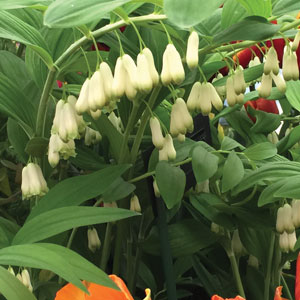Solomons Seal Growing Guide

What is Solomons Seal?
Solomons Seal (Polygonatum x hybridum) is a hardy long lived rhizomatous perennial herb. It is part of the Liliaceae family and is native to Europe and Asia. In Spring the rhizome will produce long arching stems with oval shaped mid green coloured foliage. Solomons Seal has attractive white bell shaped nodding flowers that hang below the foliage. The flowers number from 2 to 7 in a cluster and have green tips. After the flowers have finished they give way to small dark purple berries that dangle in place of the flowers beneath the leaves. Please note; the berries are poisonous and should not be eaten. When planting Solomons Seal they require a cool shady position with dapple light that has well drained soil. They like being left undisturbed to naturalise. Solomon’s seal is drought tolerant when it becomes established.
Solomons Seal is an easy maintained rhizome that makes an excellent addition to any shade garden or woodland setting. Great companion plant to other shade loving plants such as ferns and hostas. As it is tall growing it can be used to add a little height amongst other shade loving plants. Solomons Seal makes for a stylish and long lasting cut flower.
How to Grow Solomons Seal
Climatic Zones
Cool, temperate, arid.
Plant Size
Height: 60cm, Width: 25cm
When To Plant Solomons Seal
Plant in late Autumn to early Winter.
Soil Preparation
They prefer a well drained soil however will adapt to most soils. Before planting work through a well broken down animal manure, blood and bone or complete fertiliser.
How To Plant Solomons Seal
Plant in part shade to full shade, 25cm apart with rhizome at a depth of 3 to 5 cm below the surface of the soil.
Solomons Seal Plant Care
Keep moist during growing season when rainfall isn’t sufficient. Watering the plant is essential during the Summer time in dry weather, so that the rhizomes does not dry out.
Cut back dead foliage and old stems to the ground in Winter. If necessary to move the plant, lift and divide during the Winter months. You should replant it as quickly as possible.
Watch out for snails and slugs.







